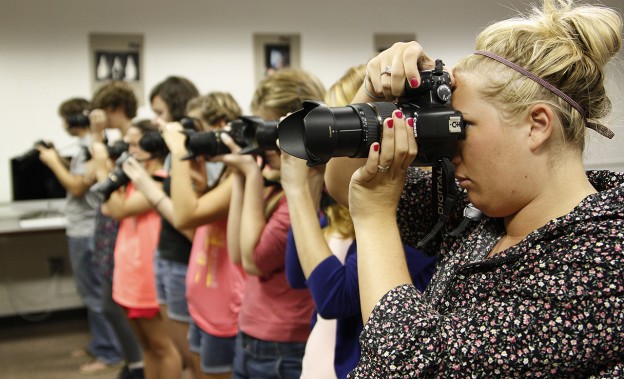Remix is a segment of education content on MediaShift, featuring interesting and innovative journalism assignments, courses and curricula. Writers will detail their ideas and work and, where possible, provide links and materials, so other educators can adapt them in their own programs. If you’re interested in sharing your approaches to be remixed at other schools, contact education curator Katy Culver.
When they say it, show it.
That is one of the core principals I teach my students when they are beginning to create audio slideshows or videos – there must be a tie between what the audience is hearing and what they are seeing. If you lose that, confusion can set in and lead to the dreaded click-away.
The concept is simple — when they say it, show it. But how do you teach it?
Shoot to Sound
In my classes, students produce all of their own content. They shoot photos (a lot of photos), shoot video and record audio. For this assignment, though, I provide the audio and they need to make the still photographs to go with it. The challenge is in listening closely to the audio and finding a way to illustrate it.
Most of my classes run at capacity with 16 students, so I sat down one morning and wrote a short script that I could easily break into 16 segments. Each chunk only runs for 20 to 30 seconds, and it narrates a walking tour across our campus. The recording was done with the same basic audio recorder we recommend to our students — the Zoom H1 — and edited in Audacity. After recording, I cut it into 16 audio files in the format needed for Soundslides. (Never used an H1, Audacity or Soundslides? I have tutorials on them for you and your students.)
When it’s time for the assignment, I drop all 16 audio segments onto the computers in the Photo Cave and send them the script so they can read through the whole piece. Our Macs are numbered, 1-16, so I just tell them to go sit at a computer and whichever machine they are at is the segment they will do. They read, they listen and then they go shoot.
For me, the challenge comes from having to listen to 16 chunks of my own voice, but the results are consistently strong. Students do find the little things I mention and they learn to both listen and see the details of our North Campus. It lets me share my experience in observing with them, in taking the time to ponder the little things on campus. I’d like to think they learn a little about our 213 year old campus, as well.
How To
Can you do this? Sure, it’s extremely simple.
- Identify how many segments you will need. If you’ll need more than 20, it may be worthwhile having students double-up on segments. They need to be able to have a significant chunk and have the overall piece not get too long or dull.
- Write the script. Put lots of detail in it but you don’t have to mention a ton of very specific items — talk about the sense of a place more than the place.
- Record the script. Find your quiet place and read it, pausing between each of your segments.
- Edit the audio. I still prefer Audacity, but you can use whatever you’re comfortable with. When I’m done, I export the files in MP3 format as that makes them small and usable with Soundslides.
- Share the audio and script. I do this using Apple Remote Desktop in my lab, but you could also post a zipped folder to Dropbox, OneDrive or Google Drive. Zipping is key when you have multiple files — you want them to be able to download everything in one shot.
- Let them shoot and produce. As noted, I’ve used Soundslides, but I’m starting to think about moving away from it. I love its simplicity, I love its elegance and I love the way it forces the students to think linearly and plan ahead. But Adobe Premiere is probably a more valuable platform to learn at this point.
Once they’ve submitted their pieces, we watch them in class. It’s important for the students to see how their classmates heard and saw their segments.
You can work up your own grading rubric based on the quality of the images, the content of the images, the timing of the transitions and the overall production quality. For me, this is a low-points-value assignment, early in the semester for my advanced classes. A little knock-the-dust-off and practice assignment that gears them up to listen and see in real time.
The benefits are huge, though. It helps them learn to listen as they are shooting both photographs and video, which in turn makes their stories much more cohesive and engaging.
Mark E. Johnson is the senior lecturer of photojournalism at the University of Georgia’s Grady College of Journalism and Mass Communication, still shoots a photo every day and comments on visual journalism at VisualJournalism.info. Follow him @markejohnson.

